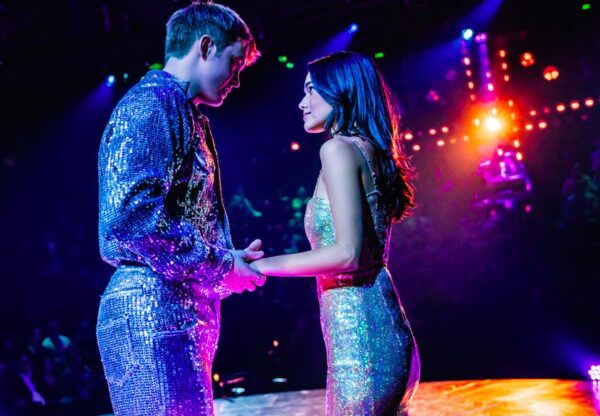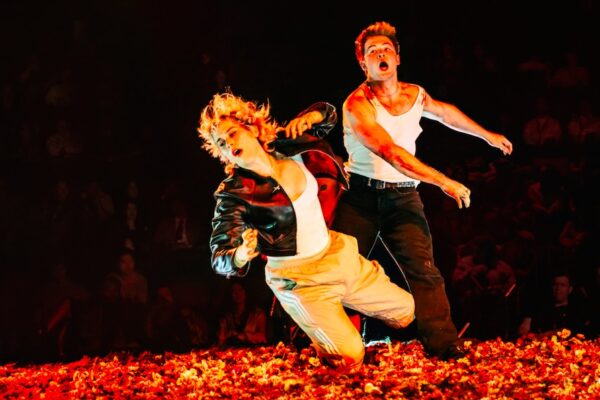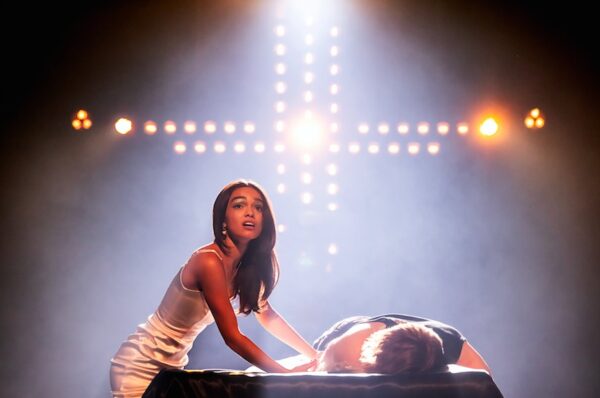Delia Ephron’s memoir Left on Tenth: A Second Chance at Life is a moving, heartbreaking account of the author’s reclaiming love and life after losing a beloved husband, finding a second amour, being diagnosed with leukemia and cancer, and dealing with endless phone prompts with Verizon. It’s funny, moving, and joyful. However, the material does not translate well from the page to the stage in Ephron’s theater adaptation now at the James Earl Jones. Perhaps it would have worked better on film since many of the scenes are so brief, some lasting only a few seconds. Though the subject matter is shattering, given that it really happened, the evening is strangely unmoving since Ephron’s script and Susan Stroman’s rapid-paced direction move so quickly we barely have time to register any reaction to the stage Ephron’s travails. The surface-oriented performances by top-billed Julianna Margulies and Peter Gallagher don’t help. They both look good but fail to delve deeply into their roles. It’s like a Reader’s Digest version of the book.

Credit: Joan Marcus
The title refers to Ephron’s Greenwich Village residence on Tenth Street, beautifully realized by set designer Beowulf Borritt’s book-lined abode which transforms to a number of settings and Jeanette Oi-Suk’s painterly projections of an idealized NYC. The play begins with writer and recent widow Delia (Margulies) explaining to the audience her frustrating struggles with Verizon which cut off her Internet access when it disconnected her late spouse’s land line. She writes a New York Times opinion piece on her conflict with the communications giant, which leads to her re-connecting with forgotten old beau Peter (Peter Gallagher), a Jungian psychologist. There’s lots of direct-address monologues, reading of emails, and many instances of the characters telling us what’s happening, but very little showing of Delia coming back to life and the couple falling in love. The tone shifts from romantic comedy to stark drama as Delia’s diagnosis—frighteningly similar to that received by her late sister Nora—is revealed.

Credit: Joan Marcus
The only sequences that truly move the emotional needle occur when Delia is at her absolute lowest. Stroman finally slows the action down and Margulies is able to deliver a truly shattering sense of her character’s pain and desperation. From her hospital bed, Delia curses Peter and pleads with him to let her die. In a brilliant stroke of stagecraft, Stroman has a tear-inducing Barbara Cook ballad play as Peter struggles to up Delia’s oxygen levels, with her falling numbers projected on the back wall. Performances, direction, design, and music all come together to convey Delia’s life-and-death climb and Peter’s loving attention. Too bad this comes towards the end of the play’s one hour and forty minutes.
The admirable Peter Francis James and Kate MacCluggage are reduced to scene-shifters as multiple friends, servers, doctors, and nurses, wheeling on gurneys, placing and removing appetizers and desserts, providing exposition. The pair, listed in the Playbill as “Featured Actor and Actress” do manage to create flashes of credible individuals with the aid of Jeff Mahsie’s versatile costumes and Michael Buonincontro’s character-defining wig and hair design. James is moving as a gay neighbor who survived AIDS and MacCluggage has several moments of connection as several of Delia’s supportive girlfriends. The dogs Nessa Rose and Charlie deserve mention for obeying commands and inspiring “awws” from the audience. The play similarly seeks to trigger Pavlovian responses of empathy, but fails to truly earn them with a quick, shallow summarizing of Ephron’s original.

Credit: Matthew Murphy and Evan Zimmerman
While Left on Tenth is based on truth and aspires to be a life-affirming tear-jerker, Sam Gold’s sexy, rock-infused production of Romeo + Juliet is a great work of fiction and succeeds in tearing our hearts out. Left on Tenth is neat, sleek, and orderly, while this R+ J reflects the insanity of youthful passion. Like Gold’s previous Broadway Shakespearean outings—his hodgepodge King Lear with Glenda Jackson and his jumbled Macbeth with Daniel Craig and Ruth Negga— his R + J is messy, but there is a method to its scattered madness.
The star-crossed lovers and their families are out of control, fiery, and the production mirrors that white-hot intensity and disorder. The rock-club set by the design team of dots is littered with stuffed animals of all sizes, like a high school on Valentine’s Day, reflecting the characters’ immaturity and their discovery of first love. The costumes by Enver Chakartash are hip and form-fitting while Isabella Byrd’s lighting creates romantic and ominous environments and moods. Halfway through the first act, the central floor flips open to reveal a carpet of flowers. Juliet’s bed descends from the flies for Romeo to chin himself up on. All of these elements contribute to the head-rush atmosphere of impulsive love, beyond the puppy stage and also impulsive violence which tears the lovers and their families apart.

Credit: Matthew Murphy and Evan Zimmerman
Identities and genders are fused and confounded. The same actor, Sola Fadiran, plays both mother and father to Juliet. (This was the only role-doubling that didn’t work for me. Fadiran makes a credible blustering Lord Capulet, but minces swishily as the Lady. He didn’t always differentiate between the two, so it got confusing at times.) The transgender actress Tommy Dorfman plays the Nurse and Tybalt, bring out the masculine and feminine aspects of each character. The Prince of Verona, Mercutio and Friar Laurence are played by the estimable Gabby Beans, who acts as a narrator of the action, guiding us along passion’s paths. She also provides juicy japery as Mercurio and sage sturdiness as the Friar.
The leads are perfectly cast. Hunky Kit Connor makes an emotionally tortured and athletic Romeo, bounding from platform to platform and from infatuation to pure love. Rachel Zegler, who played the Juliet role in Steven Spielberg’s remake of West Side Story, is equally fierce, but also conveys the heroine’s precocious intuitive intelligence. She rocks Jack Antonoff’s original song “Man of he House” and provides the rock-solid center of this youthful and exciting Romeo + Juliet.

Credit: Matthew Murphy and Evan Zimmerman
An interesting side note: the audience at the Wednesday matinee attended for Left on Tenth was mostly female, white and older. By contrast, Thursday night’s Halloween performance of R+J was attended by a much younger, more diverse crowd. It was exciting to see a youthful audience getting enthused about Shakespeare.
Left on Tenth: Oct. 23—Feb. 2, 2025. James Earl Jones Theater, 138 W. 48th St., NYC. Running time: one hour and 40 mins. with no intermission. telecharge.com
Romeo + Juliet: Oct. 24—Feb. 16, 2025. Circle in the Square, 235 W. 50th St., NYC. Running time: two hours and 20 mins. including intermission. telecharge.com
